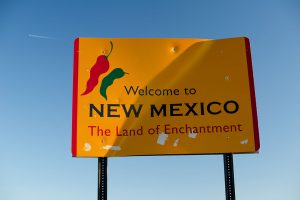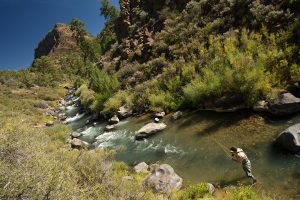Court rules unanimously that ‘non-navigable regulation’ is unconstitutional, voids existing closure certifications
From BHA:
On Tuesday the New Mexico Supreme Court issued a ruling strongly in support of public access to the state’s waters when it unanimously struck down a regulation allowing landowners to close access to streams running through their properties.
The New Mexico Chapter of BHA, along with the New Mexico Wildlife Federation and the Adobe Whitewater Club of New Mexico, filed suit in 2020 asking the court to nullify the regulation as unconstitutional. Today the court agreed. The decision not only strikes the so-called Non-Navigability Rule from the books; it also voids closures on five New Mexico streams adopted previously.
“This decision by the state Supreme Court is great news for anglers, boaters and others who use our public waters in New Mexico, but it shouldn’t come as a surprise,” said New Mexico Backcountry Hunters & Anglers Policy Chair Joel Gay. “In 1945 the Supreme Court said the same thing – that these waters throughout the state are everyone’s to enjoy for recreational use. We don’t know how that constitutional right got lost, but for decades we have been told otherwise. Our chapter thanks the state Supreme Court for setting the record straight – again.”
The New Mexico Constitution, which is based in part on Spanish and Mexican law stemming from the state’s colonial era and differs somewhat from other state constitutions, declares that all waters belong to the public. The state Supreme Court spelled out that right to access more than 70 years ago in the Red River Valley decision. Since then, however, New Mexico has treated waters that run through private property as, in fact, private.
After a state attorney general reminded residents of their right to stream access in a 2014 opinion, a small group of landowners began a battle to reduce or eliminate public access opportunities for anglers and other members of the public. They pushed a bill through the legislature giving the State Game Commission authority to give individuals with waterways running through their properties a certificate of non-navigability, along with “no trespassing” signs to post. The Game Commission established the new regulations in 2018 and immediately closed portions of five waterways to public access.
When current Gov. Michelle Lujan Grisham appointed an entirely new Game Commission in 2019, however, the new commissioners began to unwind the regulations. That, in turn, caused the governor to fire first, in 2019, the highly qualified commission chair and then, in 2021, another experienced commissioner and outdoorsman.
Read a timeline of New Mexico public waters access.
In the meantime, NMBHA and its coalition partners filed suit against the game commission, contending that the current non-navigable rule does not comport with predominant law, the state constitution. Several additional landowners applied for non-navigable certifications under the game commission rule, but when the commission refused to act, the landowners asked a federal magistrate to intervene. He forced the commission to vote on the pending applications in 2020, and all were dismissed.
The court today nullified the non-navigable regulation and voided the five existing closure certifications. NMBHA, which has consistently argued that “with rights come responsibilities,” is urging the State Game Commission to work aggressively to protect vulnerable fish stocks with catch-and-release regulations, increase law enforcement, and educate anglers on the extent of their public access rights.
“This ruling gives anglers certain rights and is a key component of reestablishing public access,” said Gay, “but it does not allow anyone to trespass across private land to either reach a stream or to leave the stream. We urge the public to recreate thoughtfully while the line between private property rights and the public’s water are further delineated. New Mexico BHA will be there every step of the way.”






3 Comments
Does anyone know if BHA lobbies on behalf of landowners to receive federal and state management resources if/when streams are opened to the public? Also, do the governments earmark funds for these resources or are new taxes imposed? Basically, I’m curious to know how all of this gets managed and funded. I don’t think a landowner would be very excited about paying out of his/her own pocket for damages related to public recreation.
Brenden, I can’t speak for BHA. but being someone that writes about these sorts of issues, I can tell you that some states do provide funds to improve waterways used by the public. This is predominately done trough grants, that help with fencing out cattle, and planting trees that help with erosion issues.
I’m not aware of other “funding issues” that property owners would have to pay.
Thanks Beau. Curious to compare state funds vs. river and land investments by actual landowners. If state funds are anything like the CRP programs, it won’t work well.